| Article ID | Journal | Published Year | Pages | File Type |
|---|---|---|---|---|
| 169024 | Combustion and Flame | 2014 | 10 Pages |
A micro flow reactor with a controlled temperature profile was examined with regard to its capabilities to investigate soot formation characteristics of rich methane/air mixtures and the formation process of polycyclic aromatic hydrocarbons (PAHs) of rich acetylene/air mixtures. In the experiment for a methane/air mixture, four kinds of flame and soot responses to equivalence ratio (1.5–4.5) and inlet mean flow velocity (5–40 cm/s) were observed: soot formation without a flame; a flame with soot formation; a flame without soot formation; and neither a flame nor soot formation. Soot formation was observed at high equivalence ratio and low flow velocity. Sooting limits depending on equivalence ratio and flow velocity (residence time) were successfully identified by the present micro flow reactor. To investigate the PAH formation process, the micro flow reactor was employed for a rich acetylene/air mixture at equivalence ratios of 4, 5 and 6 at an inlet mean flow velocity of 2 cm/s and gas sampling experiments were conducted at temperatures from 600 to 1000 K. Temperature dependence of mole fractions of benzene, styrene, naphthalene, phenanthrene, indene, acenaphthylene and biphenyl was successfully obtained and larger PAHs such as pyrene and coronene were not observed in this study. One-dimensional computation with the ABF 2.99 mechanism predicted a benzene mole fraction three times higher than the experimental result. The modification of the ABF 2.99 mechanism using recent benzene reactions greatly improved the prediction of the benzene mole fraction. The rate of production analysis was carried out and PAH formation in the micro flow reactor was investigated in detail.
